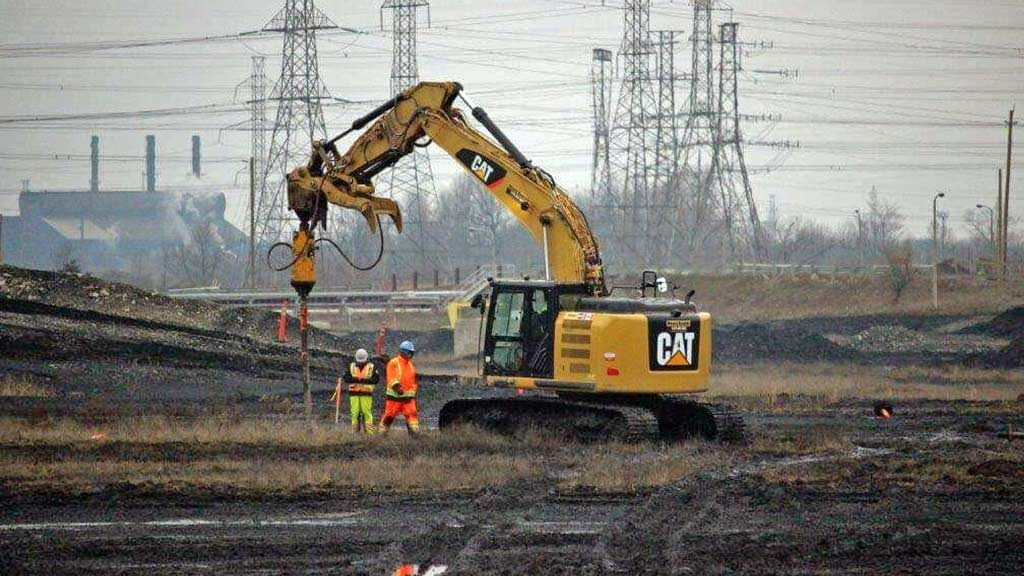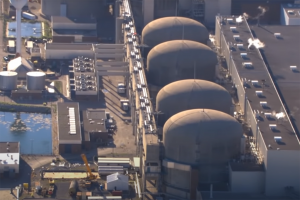The old coal-fired Nanticoke Generating Station powerhouse on the north shore of Lake Erie in Haldimand County, once the largest in the world, has been reduced to a pile of dusty and tangled rubble.
A series of controlled explosions took down the powerhouse buildings on Aug. 22, marking the end of an era.
The blasts started at the base of one of the structures and continued like a wave to the other two buildings before more charges ignited in rapid-fire succession, causing the structures to collapse in succession. Clouds of thick, grey smoke billowed from the base of the buildings as they pancaked down.
Within roughly half a minute, the powerhouse buildings — which covered nearly 500,000 square feet, or more than eight-and-a-half football fields — were safely demolished.
The plant’s landmark twin smokestacks were taken down in a controlled explosion at the decommissioned station in February 2018 after the province decided to phase out coal-fired power plants.
“The closure of Nanticoke Generating Station remains one of North America’s single largest climate change initiatives,” Mike Martelli, president of renewable generation for Ontario Power Generation (OPG) which owns the site, said in a media release issued after the takedown. “Building and sustaining a clean, low-cost electricity system is fundamental to a healthy environment and a strong, low-carbon economy.”
Demolition activities at Nanticoke started in summer 2017 and are scheduled to be completed by next summer. Preparations for the powerhouse demolition took place over several months.
Prepping the Structure
In the initial phase of the demolition, the smokestacks and all equipment external to the main powerhouse were removed, including items like fans, pump houses, transformers, silos, tanks and conveyors.
Subsequently, the main building was cleared of asbestos and process chemicals and, in a turbine building, boiler feed pumps, condensers, feedwater heaters, pedestals, turbines, and generators were removed.
Crews from Delsan-AIM Environmental Services and specialized sub-contractors cleared equipment, fixtures and mechanical components from inside the buildings, then removed lower cladding from the outside.
The demolition contractor had a two-week window beginning Aug. 19 to complete the controlled drop.
Prior to the demolition, the blast team put together a detailed plan in accordance with engineered procedures that specified exactly which columns were to be removed using explosives so that the structures would fall in a pre-determined direction.
No small detail was overlooked. Crews installed a floating membrane to cover the former station forebay, or water intake, on the lake side of the powerhouse at the beginning of the project. The intake is used to supply raw water for Haldimand County’s water treatment plant. The membrane was needed in order to protect the surface of the water from both dust and debris from demolition operations.
On blast day, an exclusion zone was established as a buffer around the area and specified roadways were closed by security personnel at designated locations. In addition, crews also patrolled the Lake Erie shoreline near the plant to ensure that no marine traffic entered the exclusion zone prior to the blast.
Setting the Explosives
Explosives and associated accessories were loaded and placed at specified locations inside the buildings over a 20-day period prior to demolition day under the direction of designated blasters.
The blast process itself involved the remote detonation of linear-shape charges and kick-charges that had been installed to cause the failure of specific structural members, allowing the buildings to collapse in a pre-determined direction. A non-electric shock tube was used to detonate the charges. Such a process ensures no premature detonations can take place due to lightning or radio interference.
The explosives were primed using detonators that were delayed in an echelon sequence — starting at one corner of a building and continuing to the opposite corner — in order to facilitate the controlled collapse of the structures.
The detonators were connected to an initiating device or blasting machine using primer cord. Once all the explosives, detonators and primer cord were installed and all preparatory work and safety checks were completed, all personnel involved in the blasting operation were evacuated to a designated safe area.
The last step involved connecting an electric detonator to initiate the primer cord sequencing, prior to the start of an auditory warning signal.
The powerhouse buildings were loaded with approximately 700 kilograms of varying types of explosives and 20,000 feet of primer cord.
A week before blast day, Martelli said the controlled drop process would take approximately 25 seconds. He was dead on and the blast and controlled drop process went according to plan.
History/Future
The former thermal-electric generating station, built in 1972, helped meet Ontario’s electricity needs for more than 40 years before burning its last piece of coal in 2013. The station consisted of eight generating units that had a capacity of 4,000 megawatts — nearly 1,000 megawatts more than the current capacity of Pickering Nuclear Generating Station.
The fate of the plant was sealed when the province decided to go off coal and determined that re-powering with a different fuel was not viable.
A 44-megawatt solar farm with 192,431 solar panels spread over 158 acres has been built on a former coal yard and adjacent agricultural lands near the shuttered plant in partnership with Six Nations of the Grand River Development Corporation and the Mississaugas of the Credit First Nation.
The farm, OPG’s first-ever solar facility, was put into service in March. The photovoltaic panels, with an average rating of 345 watts, are now converting sunlight into electricity.











Recent Comments
comments for this post are closed